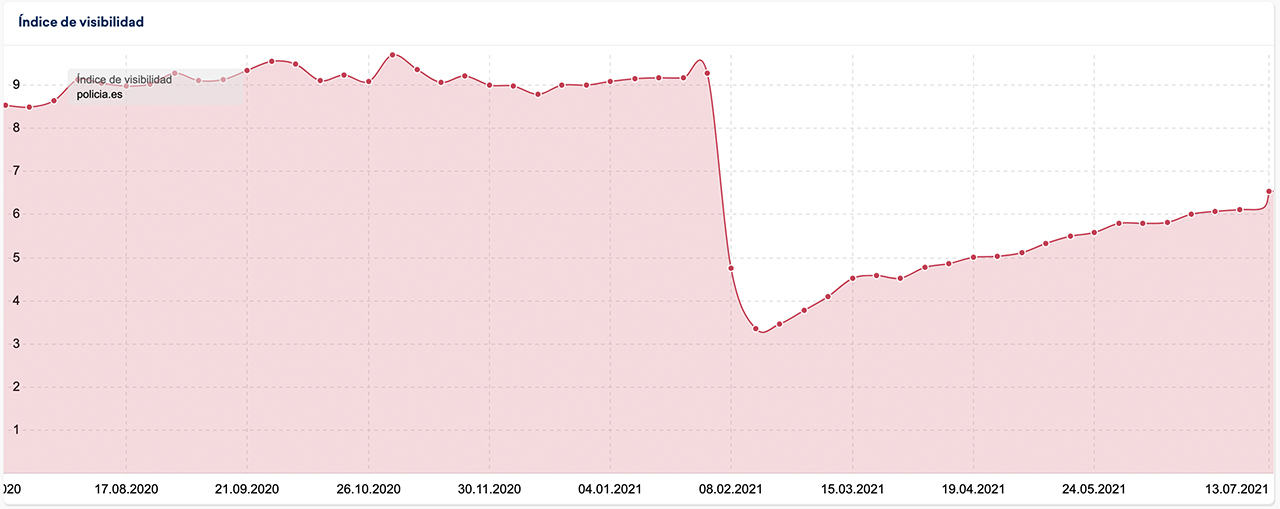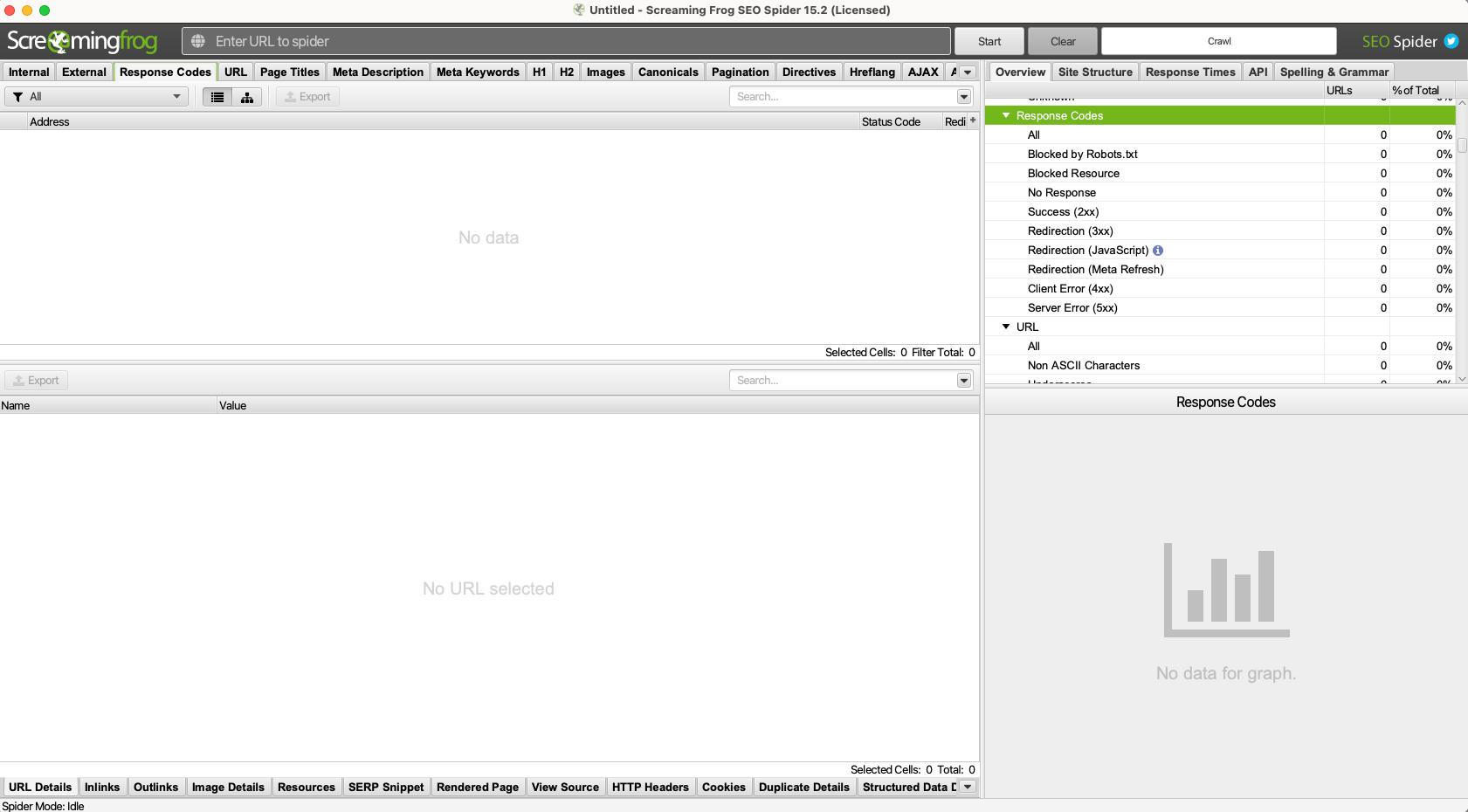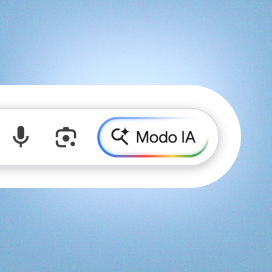Written by Jose Vicente
Index
Carrying out the migration of a website or part of it is a delicate project because it involves moving the positioning of some URLs in use to new ones and, although 301 redirects are implemented for all of them, it does not ensure that the process is transparent. In some cases, these projects are undertaken with the objective of improving positioning in the medium or long term, even if over a period of time there is a certain loss of traffic. In other cases, these projects are necessary when there is a change of content management system or technology.
By following a series of steps we can minimize the drop in traffic that is likely to occur in the short term. On certain occasions we will encounter technical or budgetary barriers that will prevent us from carrying out the process in an optimal manner, so this must be taken into account.
Below we can see the visibility trend of the domain policia.es, where a large part of its URLs were not migrated. In 6 months, barely half of the visibility prior to the site update has been recovered.
When to deploy migration
Depending on the number of URLs to be migrated and the percentage of redirects that can be implemented, the migration will be more or less risky. If we are faced with a migration project in which we know that initially there will be a certain percentage of traffic drop, it will be better to do it at a time of lower traffic trend.
If, for example, our site is a jewelry store, it is probably more interesting to carry out the migration in the summer months than during Christmas, Valentine’s Day, etc. On the other hand, if our site is related to the travel, summer will be the least appropriate time to carry out the migration since a drop in traffic in this period will be more traumatic for the site than if we do it in a period of lower traffic.
Sometimes it is not possible to avoid this, so an additional investment in advertising campaigns must be taken into account to compensate for the lower amount of traffic in order to keep the business running at the same pace. Therefore, it will be necessary to plan all this before carrying out the following tasks that we will separate into 3 different phases: before, during and after the publication of the new URLs.
Pre-production tasks
This phase contains all the tasks from the time the new URL syntax is clear until the new portal is published. It is important to perform a series of analyses and checks so that the site is ready to publish.
Evaluation of the new URL syntax
This is the first contact we have with the new development, what interests us most is to analyze how the URL syntax changes with respect to the current development. In some cases, it is used to carpetizar by categories URLs hosted directly in the domain root, remove obsolete file extensions (for example .html) or dependent on the programming language (for example .php), or generally make the URLs of the site more friendly.
Depending on the case we will be able to migrate more or less URLs and with more or less difficulty. Some casuistries are usually the following:
- The best scenario is when there is a common pattern that can be addressed with a single dynamic rule. For example, if we move from URLs ending with a file extension such as html (https://example.com/page.html), which would become the URL https://example.com/page. Generally, when the same pattern of change occurs we will be able to implement them with a single rule that will redirect 100% of the URLS of the site minimizing the impact of the migration.
- An intermediate scenario usually occurs when there is still a common pattern of change for a high number of URLs and the remaining URLs change differently. In these cases, we will have several dynamic rules that will generate most of the redirects, but also other static redirects with which we will complete as many redirects as possible.
- The worst case scenario is when there is no common redirection pattern and you have to implement them URL by URL. In these cases, the number of redirects will be limited by the number of rules to implement and there will usually be a significant number of URLs to migrate. It is possible to minimize the impact of redirects by implementing a URL handler that will check in a database which URL to redirect to.
Therefore, before proceeding with the migration we must be clear about the limitations in the number of redirections to be implemented.
What we will be able to migrate
If it is possible to migrate 100% of the URLs we will not need to perform this analysis, but if the number of redirects is limited we will have to check if all the redirects include the landings with:
- Increased SEO traffic.
- With more external links.
- Other traffic sources.
The greater the number of such URLs included in the redirects, the more successful the migration should be. If the redirects are to be static or one at a time, we will try to include all these URLs in them. It is also useful to have a list of URLs that we can migrate and the corresponding URL in the new development.
Implementation of redirection rules
The implementation of the redirection rules for the migration will fall on the technical team of the portal, technical SEOs usually help in its implementation with two objectives:
- Migrate as many URLs as possible.
- That the migration of each URL is performed with as few 301 redirects as possible. Ideally, this should be done with a single 301 redirect.
Once the redirects have been implemented in pre-production, it is necessary to check that all redirects work and meet the intended objectives. To check them in bulk we will use a crawler such as Screaming Frog, where we will enter the URLs in the old format, and test in pre-production if they return a 301 redirect to the intended URL.
Indexability checks
In addition to checking redirects, it is necessary to carry out a check of the main SEO tags that contain URLs, such as:
- Canonical link tags.
- Internal linking.
- Structured data.
- Alternate hreflang link tags (if any).
- Etc.
For each of them, we check that the definitive URLs have been implemented and that there are no crawling errors. In the case of internal linking, it is common that not all links have been updated, so an assessment is usually carried out for subsequent updating.
Rescuing popularity
In addition to the SEO on page we must take into account the SEO off page, since many of the URLs that we change will receive an important number of links that will be helping the positioning of our site. It is important to have tools that allow us to detect which high authority links are linking to us. In small sites or those where the necessary investment cannot be made, we can use the Google Search Console Links functionality but, if we have the possibility, tools like Majestic or Ahrefs can tell us which are the most important links we receive and to which pages of our site they point to.
Previously, we have already checked that we will redirect the URLs that receive the most links but, again only if we have the possibility, it would be interesting to request the change of these links to the new URLs. In general, it is complicated to make this change. It is usually easier on sites we own, sites that are part of a group, related sites or agreed links.
Copy of the sitemap in old XML format and generation of the new one.
We will make a copy of the old sitemap in XML format and prepare it for uploading to the server at the time of publication. This file will serve to indicate to Google the need to continue crawling these old URLs in order to carry out the migration, as well as allowing us to track the progress of the migration.
The new sitemap will also be generated in XML format as in any other properly optimized site, which will help the new URLs to be indexed in an agile way.
Pre-migration SEO indicators report
When it is time to migrate, just before proceeding with the migration we should take a snapshot of the site status in terms of:
- Coverage status, both indexing and error status.
- Site-specific, technical and business KPIs.
- Authority indicators.
To do this, we will set up a control panel with the status and trend of these indicators that will help us to monitor the migration once it has started. At this point, we will be able to evaluate success and detect problems in advance.
Tasks for publication
This phase of the migration will be executed immediately after the publication of the new website. It is a matter of re-performing the checks made in pre-production, but this time in production.
Review of the operation of redirections
After publication, the correct functioning of the implemented redirections is checked again in production. An attempt is made to check as many old URLs as possible, prioritizing those with the highest traffic throughput. If erroneous redirects are detected, we will have to report them immediately so that they can be implemented as soon as possible. Remember that for each URL tested, ideally there should be only one 301 redirect to the planned URL.
Indexability check
A crawl or a sufficiently significant sample of the site is performed in order to detect URLs that have not been updated and, as a secondary objective, also to identify any indexability problems that may occur after publication.
Checking the analytics configuration
We mainly check that the Google Search Console configuration is still correct after the migration, including XML sitemap file submission, configured profiles, etc. Remember that we will send the sitemap with the old and new URLs in order to monitor the migration progress.
Other configurations made in web analytics or SEO tools are also checked.
If the migration is done to another domain, a change of address will be requested from Search Console to inform Google to which domain the site changes to.
Tasks after publication
This is a follow-up phase that usually lasts approximately 1 to 3 months. Depending on the size of the site and the complexity of the migration, it will be necessary to delay this phase more or less.
Tracking of SEO indicators
Continuous monitoring of the SEO indicators established in the previous phase is carried out, warning of any error or anomaly in the data, having to be reported immediately to avoid further consequences on SEO traffic.
Updating the internal linking
If it was not possible to update the internal linking in the first phase, the update of these links to the new syntax is resumed. This will prevent internal 301 redirects from occurring and the popularity flow will be performed correctly.
Generally, we will detect these cases by crawling the site and detecting internal 301s to be corrected. This is not a critical but necessary task, which may take time, especially if it has to be done manually. In other cases, it is possible to implement some kind of code that updates the links automatically.
Updating of own and third party external links
The update of external links of higher authority is requested, generally the most feasible to update are usually those that come from:
- Websites of other sites of the corporate group, if any.
- Websites with commercial agreements.
- Links purchased.
We must be aware that if a link has been created naturally, it is unlikely that a webmaster will expend effort to change it, especially if the link is not broken because a 301 redirect has been implemented.
Post-migration SEO indicators report
After approximately 2 or 3 months, an evaluation of the indicators established prior to the migration is carried out and, thus, an assessment of the success of the migration is made.
Removal of old XML redirects and sitemaps
In some projects it is not possible to maintain the redirects indefinitely, so after 6 to 12 months (depending on the size of the site and the migration status), we will be able to remove the redirects. However, in some cases, those related to the most important sections of the site by traffic or authority are maintained.
At that moment we can also remove the XML sitemaps with the URLs of the previous development from the server and delete them from Google Search Console. Thus, we will only keep the new XML sitemaps on the server and sent to Google Search Console necessary for a correct indexing optimization.
It should be emphasized that the correct execution of these tasks (and some additional ones depending on the project) does not ensure that during the migration there will be no loss of traffic, but it will give us the possibility to face it in the best possible conditions.
More about web migrations
- How to manage your domain and its DNS configuration in a migration, by Ramón Saquete
- Fernando Maciá’s Livestream for Sistrix on how to do a Web migration in SEO






